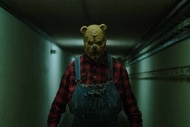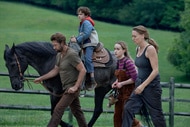Create a free profile to get unlimited access to exclusive videos, sweepstakes, and more!
Game of Thrones director breaks down how bigger budget, larger scope changed the show

Game of Thrones has come a long way over the past eight years, and for proof, all you need to do is look back at Season 1's biggest moment. In hindsight, it's not exactly as "big" as it might've seemed.
Season 1, Episode 9, "Baelor," was a game-changing moment for Game of Thrones and for genre television overall. Though readers of George R.R. Martin's A Song of Ice and Fire novels may have seen the death of Eddard Stark (Sean Bean) coming all along, it still caught many of the show's viewers by surprise, and set a whole new tone for the rest of the series. The show's moral center, and its only clear heroic figure at that point, was simply gone, and we were left watching a series where anyone might die at any time, as the show has since proven to be true time and time again.
The execution of Eddard Stark is, in retrospect, about more than just the storytelling ramifications of the scene. As "Baelor" director Alan Taylor explains in a new interview with Vanity Fair, the scene can also be viewed now as a demonstration of just how little the show had to work with in those early days, and how far it's come since.
When Taylor — whose credits include seven episodes of Game of Thrones, including last season's massive "Beyond The Wall" — directed "Baelor," there was no real established Game of Thrones fanbase beyond readers of the books who were interested in how the show would turn out. In those days, HBO was trying to do a lot with very little, and that meant budget restraints. So, as Ned Stark was led out to his death in a great courtyard where all of King's Landing was supposed to be watching, the set mostly consisted of one big statue (the titular Baelor), a few dozen extras, and a basic platform with some banners behind it.
"It's funny watching it now and seeing just how small and sort of rinkydink the scene is, because Game of Thrones has gone on to be very well-funded by HBO," Taylor said. "But at this stage, this was Season 1, no one had seen the show yet, we had no idea if it had an audience or not, and we didn't have a dime."
A particularly interesting example of these budgetary constraints can be found early in the scene, when Arya Stark (Maisie Williams) walks into the gathered crowd and climbs up onto the statue of Baelor so that she can see her father. As Taylor points out, the camera continues to crane up higher to show the top of the statue, then tilts toward the sky before coming back down to show the assembled crowd again. That camera angle was chosen because, when the episode was shot, Taylor was expecting a massive CGI Great Sept of Baelor to be seen on the city skyline, overlooking the courtyard. By the time the episode entered post-production, there was no money left to create the Sept, so we're left with an open sky.
"When I watch it now, I see just how little money we had at the time, but I think it still packs an emotional punch," Taylor said.
For more big and small indications of how "Baelor" was made on a much tighter budget that Game of Thrones is used to now, check out the full video above. Game of Thrones returns April 14 on HBO.


























